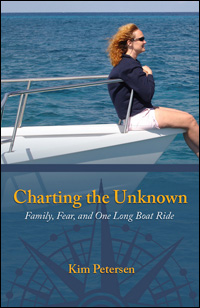Who was aboard?
• Mike is the CIO of a Charitable Foundation. Throughout our time cruising, he was a money manager, using the internet to keep up to date and make a living, something he still does.
In addition, he has traveled all over the United States and Canada leading motivation and instructional seminars.
When not engaged in business affairs, he designed and built by hand three customs homes and the 65 ft. powercat, Chrysalis.
• Kim has been published in numerous periodicals including Living Aboard, Multihull Quarterly and Southern Boating and has appeared on Lifetime Television's The Balancing Act, FOX NEWS, CBS News at Noon, and KCMN Radio.
Her book, Charting the Unknown: Family, Fear and One Long Boat Ride was released through Behler Publications in 2010.
Along with Mike, she has traveled to the US and Canada leading motivational and instructional seminars. She is a Professional Life Coach and enjoys helping others move beyond fear to accomplish their dreams.
• Lauren, now 20, currently lives in Vancouver, British Columbia, Canada. She is taking a year off from university before pursuing a career as a Doctor of Naturopathy. She continues to love cruising and worked for a time on a fishing boat on Lake Ontario.
• Stefan, age 17, still lives on board Chrysalis. For his junior year he went to the local high school for the first time since the second grade. Although he enjoyed it, he opted to be homeschooled again for his senior year. He is interested in criminology.
• Skipper the boat dog has lived all his life on board
Chrysalis. Despite this, he remains afraid of the water. When not chasing gulls off the stern, he enjoys snuggling up with a human sibling or taking walks along the beach. He's been a wonderful dog to travel with and we've all enjoyed his company.
What kind of boat do you have?
A custom 65 ft power catamaran. She was designed by Malcolm Tennant, of New Zealand, well known in catamaran circles for his innovative design. The cored fiberglass hull was built by Pachoud, the inside by the Petersen family.
Where have you been?
Up and down the eastern seaboard of the US and Canada, visiting such wonderful cities as Halifax, New York City, Boston, Norfolk, Washington D.C., Baltimore and Annapolis as well as the Bahamas including the Abacos and Eleuthras.
In 2007, we crossed the Atlantic Ocean on our own. Several cruising authorities have told us we are the first power catamaran on record to cross the Atlantic Ocean.
We went from Jensen Beach, Florida via Bermuda, the Azores, Madeira, making landfall in Ceuta, Spain on the northern tip of Morocco. We then spent over two years traveling to Gibraltar, Spain, France, Italy, Malta, Greece, Turkey, Israel, and through the Suez Canal into Egypt.
Where are you now?
We are currently still living aboard in south Florida where we continue to work and attend school.
Kim Petersen's website
www.thewanderingobserver.com
Kim Petersen's book
 |
Charting the Unknown: Family, Fear, and One Long Boat Ride
by Kim Petersen, through Behler Publications.
The travel genre is full of solo travelers who have trekked across the globe and done a remarkable job of telling the tale, but few stories are told of families who embark on a six year boating odyssey with teenagers in tow.
This book will appeal to anyone who has sought to rebuild their life after great personal loss or are interested in living intentionally and creatively. There is certainly adventure and humor in the form of four individuals acclimating to a foreign nautical world and crossing the Atlantic Ocean, but even more telling, the age-old human struggle to push through obstacles and achieve the impossible is portrayed in these pages.
If these things are of interest, you’ll find a friend in Charting the Unknown. For more information please see www.thewanderingobserver.com
|